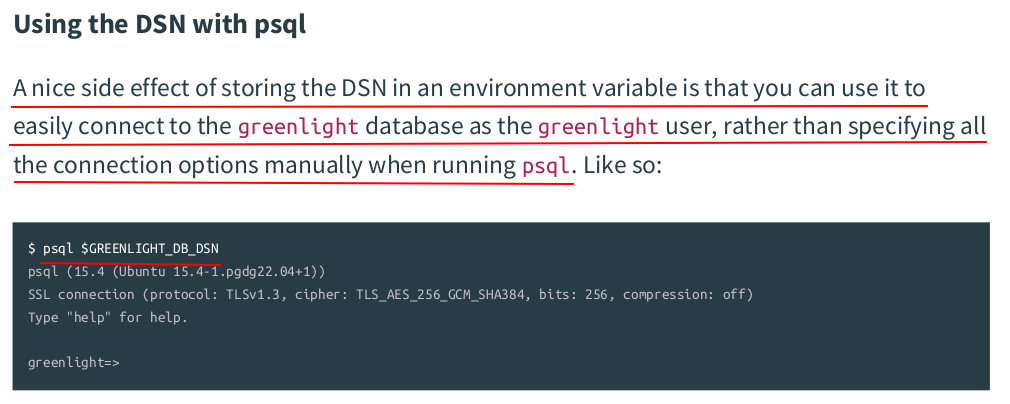zzh@ZZHPC:/zdata/Github/greenlight$ docker pull postgres zzh@ZZHPC:/zdata/Github/greenlight$ docker run --name postgres17 -p 5432:5432 -e POSTGRES_USER=root -e POSTGRES_PASSWORD=root -d postgres:latest

zzh@ZZHPC:~$ docker exec -it postgres17 psql -U root psql (17.1 (Debian 17.1-1.pgdg120+1)) Type "help" for help. root=# SELECT current_user; current_user -------------- root (1 row) root=# CREATE DATABASE greenlight; CREATE DATABASE root=# \c greenlight You are now connected to database "greenlight" as user "root". greenlight=#


greenlight=# CREATE ROLE greenlight WITH LOGIN PASSWORD 'greenlight'; CREATE ROLE greenlight=# ALTER DATABASE greenlight OWNER TO greenlight; ALTER DATABASE greenlight=# CREATE EXTENSION IF NOT EXISTS citext; CREATE EXTENSION greenlight=#
Once that’s successfully done, you can type exit or \q to close the terminal-based front-end and revert to being your normal operating system user.
Connecting as the new user
zzh@ZZHPC:~$ docker exec -it postgres17 psql --dbname=greenlight --username=greenlight psql (17.1 (Debian 17.1-1.pgdg120+1)) Type "help" for help. greenlight=> SELECT current_user; current_user -------------- greenlight (1 row) greenlight=> exit

You can check where your postgresql.conf file lives with the following SQL query:
zzh@ZZHPC:~$ docker exec -it postgres17 psql -U root
psql (17.1 (Debian 17.1-1.pgdg120+1))
Type "help" for help.
root=# SHOW config_file;
config_file
------------------------------------------
/var/lib/postgresql/data/postgresql.conf
(1 row)
root=#
This article provides a good introduction to some of the most important PostgreSQL settings, and guidance on what values are reasonable to use as a starting point. If you’re interested in optimizing PostgreSQL, I recommend giving this a read.
Alternatively, you can use this web-based tool to generate suggested values based on your available system hardware. A nice feature of this tool is that it also outputs ALTER SYSTEM SQL statements, which you can run against your database to change the settings instead of altering your postgresql.conf file manually.
zzh@ZZHPC:/zdata/Github/greenlight$ go get github.com/jackc/pgx/v5 go: downloading github.com/jackc/pgx/v5 v5.7.1 go: downloading github.com/jackc/pgx v3.6.2+incompatible go: downloading github.com/jackc/pgservicefile v0.0.0-20240606120523-5a60cdf6a761 go: downloading golang.org/x/text v0.20.0 go: added github.com/jackc/pgpassfile v1.0.0 go: added github.com/jackc/pgservicefile v0.0.0-20240606120523-5a60cdf6a761 go: added github.com/jackc/pgx/v5 v5.7.1
DSN:
postgres://greenlight:greenlight@localhost/greenlight?sslmode=disable

File: cmd/api/main.go:
func createDBConnPool(cfg config) (*pgxpool.Pool, error) { ctx, cancel := context.WithTimeout(context.Background(), 5*time.Second) defer cancel() config, err := pgxpool.ParseConfig(cfg.db.dsn) if err != nil { return nil, err } config.MaxConns = int32(cfg.db.maxOpenConns) config.MaxConnIdleTime = cfg.db.maxIdleTime p, err := pgxpool.NewWithConfig(ctx, config) if err != nil { return nil, err } err = p.Ping(ctx) if err != nil { p.Close() return nil, err } return p, nil }


flag.StringVar(&cfg.db.dsn, "db-dsn", os.Getenv("GREENLIGHT_DB_DSN"), "PostgreSQL DSN")

type config struct { port int env string db struct { dsn string maxOpenConns int maxIdleTime time.Duration } }
flag.IntVar(&cfg.db.maxOpenConns, "db-max-open-conns", 25, "PostgreSQL max open connections") flag.DurationVar(&cfg.db.maxIdleTime, "db-max-idle-time", 15*time.Minute, "PostgreSQL max connection idle time")






【推荐】国内首个AI IDE,深度理解中文开发场景,立即下载体验Trae
【推荐】编程新体验,更懂你的AI,立即体验豆包MarsCode编程助手
【推荐】抖音旗下AI助手豆包,你的智能百科全书,全免费不限次数
【推荐】轻量又高性能的 SSH 工具 IShell:AI 加持,快人一步
· 震惊!C++程序真的从main开始吗?99%的程序员都答错了
· 【硬核科普】Trae如何「偷看」你的代码?零基础破解AI编程运行原理
· 单元测试从入门到精通
· 上周热点回顾(3.3-3.9)
· winform 绘制太阳,地球,月球 运作规律
2023-11-15 Microservice - Hexagonal Architecture